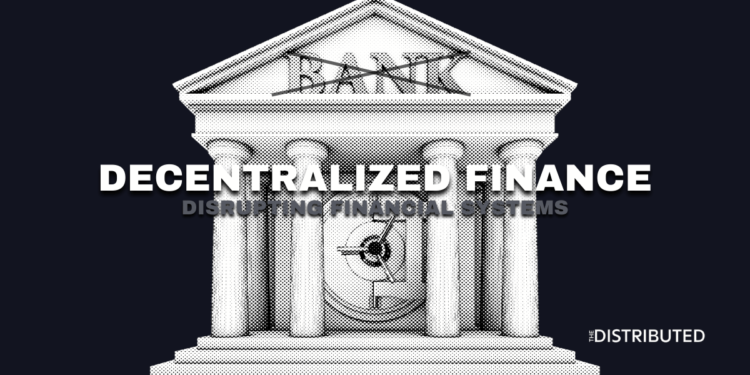What Is Decentralized Finance (DeFi)?
Decentralized finance (DeFi) is a collective term that describes emerging financial applications aimed at disrupting traditional financial systems. Through the elimination of the intermediary, the control financial institutions have upon money is minimized.
DeFi applications are typically owned and run by the users of the application, through something like a decentralized autonomous organization (DAO).
How Does DeFi Work?
DeFi applications, known as decentralized applications (dApps) are based upon distributed ledger technology utilizing smart contracts and cryptocurrencies. This gives users control and visibility over their money, being available to anyone with an internet connection.[1]Ethereum – Decentralized Finance
The ledger technology used by DeFi records the ins and outs of a system, allowing for complete traceability of transactions. Records are verified by other users, called nodes. Once this process has taken place the data is encrypted within a block which is added to a chain of previous blocks, thus creating a blockchain.
The intermediary is replaced by smart contracts, which are public and immutable contracts that send and return funds based upon pre-determined conditions.
Where Can I Use DeFi?
Through the development of dApps, there is almost a decentralized alternative to every financial service currently available. The premise of DeFi is built upon Peer-to-Peer (P2P) transactions, those without the need for a third party like a bank.
To use a majority of dApps, you must use a stable asset called a stablecoin, as they are much more easily implemented and less volatile compared to traditional cryptocurrencies.[2]Wharton, University of Pennsylvania. “DeFi Beyond the Hype, The Emerging World of Decentralized Finance” – Page 8
DeFi is typically used for sending money, borrowing funds against collateral, lending money, derivatives, and saving your funds.
Decentralized Finance vs Centralized Finance
| Decentralized Finance | Centralized Finance |
|---|---|
| Crypto/Stablecoins. | Fiat currencies. |
| You hold your money. | Custodian holds your money. |
| Full control over your money. | Money is in the control of financial institutions. |
| Funds move in seconds/minutes. | Funds move in days/weeks. |
| Transactions are pseudonymous. | Transactions are public to institutions. |
| Anyone can use it. | Must apply to use. |
| Open Source | Third-party Audits |
| Public Ledger | Private Ledger |
| Users assume risk. | Financial institutions assume risk and consumer protection. |
Is There A Future In DeFi?
DeFi has the ability to revolutionize the financial sector. The access it provides to banking applications without the middle man has seen exponential growth in the past few years, showing that consumers are keen on a different experience in financial services.[5]Greyscale – DeFi Report 2021, Page 16
Although, due to challenges in regulation and the infancy of the technology running DeFi, hacks, scams and bugs overwhelm the industry.[6]Wharton, University of Pennsylvania. “DeFi Beyond the Hype, The Emerging World of Decentralized Finance” – Page 7 [7]Greyscale – DeFi Report 2021, Page 24 Nothing innovation cannot fix though.
The future of DeFi is still in question but it has already proved that financial services do not need an intermediary. The question still remains if DeFi does succeed how, will financial institutions respond to a large portion of their cash flow moving to decentralized platforms?
References



